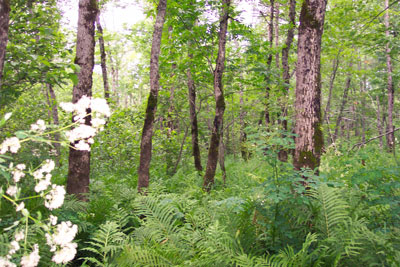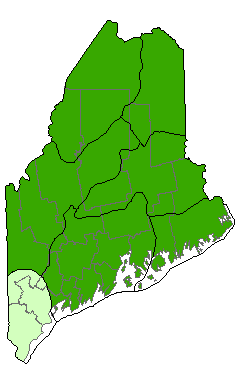DACF Home → Bureaus & Programs → Maine Natural Areas Program → Communities, Plants, and Animals → Natural Community Fact Sheets → Black Ash Swamp
Printer Friendly Fact Sheet - 870 KB pdf (Get a free copy of Adobe Acrobat Reader)
Black Ash Swamp
Scientific Name: Black Ash Swamp; State Rank: S4
This is a new community type in Maine, differentiated from Red Maple Swamps and Northern White Cedar Swamps.

- Community Description
- Soil and Site Characteristics
- Diagnostics
- Similar Types
- Conservation, Wildlife and Management Considerations
- Distribution
- Characteristic Plants
- Associated Rare Plants
- Associated Rare Animals
- Examples on Conservation Lands You Can Visit
Community Description: This northern forested wetland type is characterized by a hardwood or mixed overstory and lush understory on shallow peat or muck soils. While black ash is characteristic in these small-patch communities, Black Ash Swamps often occur within or adjacent to larger expanses of Northern White Cedar Swamps or Red Maple Swamps and may be transitional between the two. Tree cover ranges from 25-80%. Common plants of forested wetlands are often dominant in the understory, including sensitive fern, royal fern, marsh fern, tussock sedge, small manna grass, and spotted touch-me -not, as well as a scattering of rich-site wetland herbs including purple avens, Robbins' ragwort, foamflower, small enchanter's nightshade, and white turtlehead. Mosses and liverworts are usually abundant and may form a continuous carpet. Back to top.
Soil and Site Characteristics: Black Ash Swamps occupy broad basins or seepage sites on lower gentle slopes, often in association with larger areas of cedar or red maple swamp. They typically occur in rolling to low terrain in central and northern regions of the state where higher pH soils or groundwater discharge occur. Saturated soils of well decomposed organic matter (peat or muck) are typical and surface rivulets and springs are occasional. Back to top.
Diagnostics: Black ash is dominant or co-dominant (at least 40% cover) with northern white cedar or red maple in a wetland setting. Sensitive fern and royal fern each form more cover than cinnamon fern. Back to top.
Similar Types: Northern White Cedar Swamps and Evergreen Seepage Forests each have more conifer than hardwood cover in the canopy. Red Maple Swamps have more red maple than black ash in the canopy. Back to top.
Conservation, Wildlife and Management Considerations: Wind is apparently the primary form of natural disturbance in these swamps, as black ash is shallow-rooted. Although black ash does not grow as fast as other species, its ability to stump sprout may be an important reproductive strategy in response to disturbance. Black ash is fairly long lived (>250 years). Beavers have altered many black ash swamps, converting them into open or shrub-dominated wetlands.
Breeding birds include great-crested flycatcher, brown creeper, veery, and northern waterthrush. Wood ducks may also breed in these swamps if there is open water available. Back to top.
Distribution: New England - Adirondack Province and Laurentian Mixed Forest Province. Most common in northern and eastern Maine, and likely extends to the east, west, and north. Landscape Pattern: Small patch. Back to top.


Characteristic Plants: These plants are frequently found in this community type. Those with an asterisk are often diagnostic of this community.
- Canopy
- Black ash*
- Northern white cedar*
- Red maple
- Yellow birch
- Sapling/Shrub
- Alderleaf buckthorn*
- Black ash*
- Mountain holly
- Northern white cedar
- Red maple
- Speckled alder*
- Winterberry
- Witherod
- Herb
- Foamflower
- Marsh fern
- Purple avens
- Robbins' ragwort
- Royal fern
- Sensitive fern*
- Small enchanter's nightshade
- Spotted touch-me-not
There are no documented rare animals associated with this natural community.
Examples on Conservation Lands You Can Visit
There are no documented examples on conservation lands that you can visit associated with this natural community.